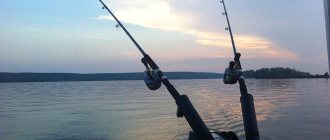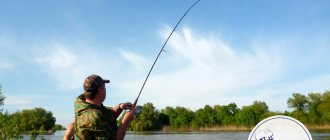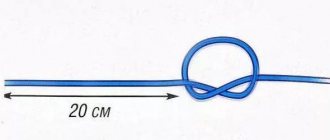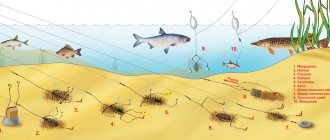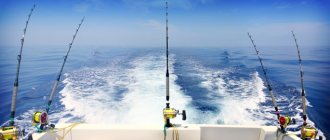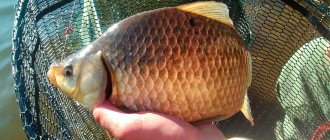Among the great variety of types and methods of fishing, trolling stands apart. This is largely due to the ambiguous status of this type of fishing. After all, until recently it was banned in Russia. These days, the bans have been partially lifted, but in some regions restrictions continue to apply.
It is worth noting that this method is quite expensive. To satisfy your own ambitions, you will need to acquire a swimming device and equip it with a motor. Add to this a high-quality echo sounder, fairly powerful equipment and expensive baits. Some representatives of this “class” do not limit themselves to this, adding special devices to their arsenal that allow them to reach a higher level of fishing skill. Downrigger is one of them.
What is a downrigger
It is known that some species of fish (especially their largest representatives) live most of the time at decent depths. And getting to them, using all the variety of modern baits, can be quite difficult for fishermen, and often simply impossible.
Using a downrigger allows you to solve such problems by delivering the bait to the desired layer of water. The necessary information, both on detecting the fish itself and the depth of its habitat, will be provided by an indispensable assistant in this matter - a multifunctional echo sounder. The most popular depth range for downrigger fishing is 10 to 30 meters. If desired, a depth of 100 meters can be achieved. To do this, it is enough just to increase the weight of the load.
What is Trolling and what are its Advantages?
Trolling is considered one of the most popular and productive methods of fishing in large water areas.
The basic principle of this method is to freely tow the tackle, with the bait attached to it, behind the moving boat. This fishing method can cover a very large part of the reservoir.
In most cases, catching fish at a depth of 6-14 meters requires the use of additional devices to lower the bait to this depth.
The most widely used device among fishermen is a downrigger, invented more than a century ago by Canadian fishermen Scott and White.
Downrigger design
A device that is essentially reminiscent of a simple winch with a small reach and a pulley at the end. The downrigger is rigidly attached to the transom or side of the boat. Consists of the following main elements:
- Volumetric drum with a handle for winding the cable and a stopper function. On more advanced models there is a depth indicator in meters.
- The thickness of the downrigger cable depends on the degree of its load and the intensity of the current. For convenience, marks can be placed on the cable indicating the amount of immersion.
- A load, usually drop-shaped, is suspended at the working end of the cable. Its weight is directly dependent on the fishing depth. Approximately, for every 10 m of dive, the weight of the downrigger load is increased by 1 kg.
- At 35 - 45 cm from the load, a very important piece of equipment is attached to the cable - a clip (clothespin) into which the fishing line is tucked.
- The rod itself (usually a powerful spinning rod) is inserted with the butt into the holder, next to the downrigger.
Photo 1. Downrigger kit.
Thanks to the many models on the market, every angler can choose the most suitable downrigger for himself. The only differences are in their sizes and materials. The most expensive models are equipped with an electric drive and a gear depth counter. Canadian manufacturers are rightfully considered the leaders in this industry.
Photos of downriggers
Note!
How to minimize fishing costs? Useful tips from experienced fishermen and an overview of current solutions (65 photos)Do-it-yourself boat motor - tips for beginners, projects, drawings and step-by-step description of the construction of the main components and elements (video + 120 photos)
Feeder for winter fishing - secrets of use and techniques for feeding fish in winter (115 photos)
Help the project, share on social networks
1+
Operating principle
Despite some design differences and additional options, the operating principle of the entire family of downriggers is the same.
- The cable from the drum is pulled along the boom and hung above the water through a pulley. In this case, the boat moves at low speed.
- A load of the required weight is attached to the cable and a clip is attached.
- The spinning line with bait is lowered into the water several meters (depending on fishing conditions).
- Next, the fishing line is fixed with a clip. The degree of fixation should not be excessive, otherwise the bite may simply not be noticed. The fish must use its own power to release the line from the clip.
- Hold the drum with your hand and release its brake. It is important to adjust the multiplier brake of the fishing rod to the minimum resistance.
- Once the specified depth is reached, tighten the brakes on both the reel and the bait reel. Take out the slack in the fishing line and set the spinning rod in the working position so that its tip is bent into a small arc.
- At the moment of a bite, the fishing line snaps out of the clip, the rod straightens sharply and automatic hooking occurs. It is important for the fisherman not to miss this event and, taking the spinning rod in his hands, carefully bring the fish to the surface and catch it with a landing net.
- Then you need to lift the weight and load the line into the clip again. The tackle is ready for use again. Of course, having the electric drive option available, the process of controlling the gear is much more comfortable and efficient.
Advice!
It is important to exclude any possibility of the cable getting into the working area of the propeller when performing any ship maneuvers. Advantages of using a downrigger:
- The main advantage of the device is that the bait is placed in a given horizon.
- Ability to work with absolutely any bait.
- Contact with biting fish is not limited in any way. The process of fishing it is a matter of technique for the fisherman himself.
- The ability to choose when purchasing the most suitable model option for a specific watercraft, purpose and wallet.
- The probability of catching rare species of deep-sea fish (trout, trout), as well as trophy pike, catfish, and pike perch, increases.
Photo 2. Upper part of the device.
Among the disadvantages mentioned by fishermen are:
- Relative bulkiness of powerful versions of the device.
- Decent price.
- The need to make your own weights.
Downrigger
Walker line securing system
The angler can now see on the 25-inch screen how the fish attack the bait and sit on the hooks. Then these shots can be replayed more than once in the company of friends as actual confirmation of your fishing exploits. Of course, such pleasure costs money, and the camera is more applicable in clear sea water.
For the first time, I myself had to verify the effectiveness of a conventional downrigger with a manual winch when catching pike perch on Seliger. On the large reaches of the lake it is not so easy to find fish, and sometimes it is even more difficult to catch it. With an echo sounder and downrigger, the chances of catching a predator using artificial bait increase several times.
One day, my partner and I had to spend a long time ironing one of the reaches on an electric motor in search of a pike perch that did not want to be discovered. Several “travelers” who met us that morning only shrugged, and not at all in order to show the size of the fish they had already caught.
Finally, when we were moving in splendid isolation above a large underwater plateau, located at a depth of 15 meters, single silhouettes of fish began to appear on the echo sounder screen 5 meters below the boat. Having placed the load a meter lower, so as not to scare away potential trophies, we secured the fishing lines from two rods in the clamps on the cable.
One bait - a wobbler - was exactly at a depth of 5 m, the other - a “locomotive” made of a vibrotail and a wobbler - was 70 cm higher. Downrigger with two rods. was placed on the stern, and four more rods along the sides worked as ordinary “tracks” with wobblers and silicone at the ends of the fishing lines. The depth of immersion of baits on them was determined, as they say, “by eye.”
The very first pass of the boat over a fish standing in the water brought a couple of bites and one pike perch. What kind of tackle did the fish use? You guessed it! Of course, to the one that we were able to trace with centimeter accuracy at the depth we needed using a downrigger! Then we were expecting more bites and pike perch pulled out from the depths, but this was already a matter of technique.
And by the evening the local oral fishing radio reported that the bite on the lake for everyone that day was “well, just nowhere,” with the exception of two eccentrics who were very lucky. So think, gentlemen fishermen, to have or not to have, or rather, to catch or not to catch...
Author Vladimir Struev
fishcom67.ru
We have already become accustomed to the English term “trolling”, which has recently entered our fishing lexicon. The word “troll” is interpreted in the dictionary as “catching fish by towing a hook with bait in the water.” At first, our fishermen associated trolling with the traditional “track”, fishing for which was known in many regions of Russia long before Leonid Pavlovich Sabaneev. But as it turned out later, trolling is a whole system of several independent methods of freshwater and sea hunting for predatory fish. The trivial “path” in this series is the most primitive type of such fishing, which involves a large element of chance or luck, when the fisherman purely empirically finds fish sites and cannot control the depth of the bait without a noticeable error. But in many reservoirs, especially in the middle of summer, situations often arise when the success of fishing directly depends on the accuracy of fishing at a strictly specified depth.
Our colleagues on the North American continent have long been looking for ways to improve the efficiency of trolling gear. More than one original thought was put into various devices for placing natural and artificial baits - remote arrows, gliders, deepening plates and other systems that help baits to go at different depths, and anglers to fish as much of the reservoir as possible. But of all the trolling devices that have appeared on the European fishing tackle market over the past few decades, the downrigger has broken all records as the most effective fisherman's assistant ever created by the active design mind. The concept of a downrigger is by no means new. Back in the early 19th century, Indians on the Great Lakes used primitive downrigger designs for fishing. And the first real downrigger was patented as a tackle for industrial fishing and was used on the West Coast of the United States for deep-sea fishing. Later it was successfully used in sport salmon fishing on Lake Michigan. An exact description of the ancient downrigger has not been preserved; all that is known is that the first designs consisted of a load resembling a window frame in shape, lowered to the required depth on a strong cable with trolling lines attached to it. Salmon hunters began to improve the fishing process, and new components began to appear in the downrigger mechanism. One of them is a large tricycle wheel mounted at the stern of the boat. The tire was removed from the wheel rim and a cable was wound in its place; a frame weight was attached to it, which was lowered and raised by rotating the pedals. This device was quite crude, but it became the basis for the sophisticated downrigger system used today. So, what is a modern downrigger, how do you fish with it and what advantages does it have? Simply put, in a nutshell, this is a device that allows a fisherman from a boat to present an artificial or natural bait to the fish at a depth adjusted to the nearest centimeter, and this depth no longer depends on the size, weight and shape of the bait chosen by the fisherman. The central mechanical part of the downrigger is a small winch with a thin cable wound around its drum. The end of the cable is passed through a pulley on a bar or boom. A heavy weight is attached to it through a swivel. This entire structure is attached to the stern or to the sides in the stern of the boat. In addition, one or two tubular rod holders are mounted on or near the downrigger body on board. You should not use more than two rods with one downrigger, otherwise the entire installation will turn out to be too cumbersome and unmanageable. And there is also the danger of the lines overlapping when handling the load.
Three downriggers on one boat
A special clip-clip for fishing line is attached to the weight on a small leash. The clip holds the fishing line from one of the rods. We will discuss the distance from the attachment point to the bait, the choice of which depends on fishing conditions, below.
Adapter for attaching a clip with a leash to a cable
By rotating the winch, the weight and fishing line with bait are lowered into the water. It is better to perform this operation while the boat is moving, so that the fishing line with the bait immediately, without getting tangled, is pulled out behind the stern. The second clip is installed directly on the cargo cable above the load, the fishing line from the second fishing rod is inserted into it, also leaving the required distance to the bait, and then the load is lowered to the required depth. The brakes on the reels (for fishing with a downrigger, multipliers are better suited, although ordinary “inertia-free” ones work well) are loosened when lowering the load, but not to the limit, but so that the line goes under a slight tension, without breaking out of the clip clamp and at the same time at the same time without forming a large arc in the water column between the rod and the clip while the boat is moving. The downrigger is usually equipped with a counter for the depth of lowering the load. In the simplest models, the meter scale is replaced by marks placed directly on the cable with a waterproof marker. When the load reaches the required depth, the drum is locked. Now you need to wind the lines onto the reel spools to such an extent that the rods bend into tense arcs under the action of tension between their tips and clips. Now everything is ready and you can direct the boat along the route planned for fishing. The baits come on two levels, and the angler knows exactly at what depth.
Downrigger in action
When a fish takes one, it will rip the line out of the clip. At the same time, the rod will instantly release tension and straighten sharply. As a rule, at this moment an automatic hooking occurs, and the angler can only correctly bring the fish on the fishing line released from the clip to the surface and take it into the landing net. The fisherman’s task is also made easier by the fact that on the rod rig itself there are no unnecessary obstacles in the form of sinkers complementing the bait, as in conventional fishing, since the function of accurately “pointing” a wobbler or vibrotail at the target is taken over by the downrigger. Therefore, the fish has much less chance of freeing itself from the hooks. For downrigger fishing, it is better to use rods with a soft action. In this case, even with a fairly strong tension between the rod tip and the clip, the line is released only when there is a bite. Otherwise, you will have to clamp the line harder, and then a small fish simply will not be able to pull it out of the clip, and the bite will have to be determined by the tip of the rod twitching weakly from the jerks of the predator. At the same time, the fisherman himself, with a sharp movement, releases the fishing line and then fishes out the prey.
Moment of bite
But the effectiveness of the downrigger will disappear to almost nothing, and it will turn into an ordinary “blind track” if it is not supplemented with an echo sounder. Thanks to the echo sounder, you can accurately determine at what depth the fish are holding. Based on its readings, you can clearly set the depth of the bait and ultimately serve it to predators “on a silver platter.” In addition, an echo sounder will help determine the structure and topography of the bottom in the fishing area. The metal weight is reflected on its screen as a solid line, so guiding the bait along the bottom is not at all difficult - just raise or lower the weight as you move, clearly following the bottom relief. The echo sounder will tell the fisherman about other useful facts, but the main thing is at what depth the fish is located. Trolling speed depends on the type of bait, the fishing depth, and even the attack style of the predator. When fishing with a live or dead fish in a rig, they try to give it the most natural movement possible, and a very low trolling speed is appropriate here. Artificial baits are faster. But we must remember that as the speed of the boat increases, the downrigger cable deviates more from the vertical. Since the trolling speed is low with a downrigger, it is better to use an electric motor for fishing in lakes and reservoirs, and use a gasoline motor only to get to the place. Another important aspect of fishing with a downrigger is the behavior of the bait during trolling. Experienced fishermen, before starting fishing, check the progress of a particular bait visually, next to the boat, selecting the most effective fishing speed for it, and therefore the speed of the boat itself. If the bait is of a diving type, the depth of its movement should be taken into account when installing the load, especially when fishing is carried out near the bottom. For example, a wobbler that goes 3-4 m deep during regular spinning fishing when trolling with a downrigger can go the same 3-4 m below the point at which the fishing line is clamped. Another issue that will also have to be decided based on fishing experience is the length of the fishing line from the clamp to the spoon. This question is no less important than the previous one. The general rule is: the more careful the fish, the greater the distance from the spoon to the clip. Some manufacturers include tables with downriggers that allow you to determine the optimal length of line release from the clamp to the bait when fishing for different types of fish and even the water temperature at which these fish are most active. For example, Walker downriggers suggests catching pike perch with bait released from 12 to 18 m at temperatures from 12 to 18 ° C, pike - 2.5-18 m from the clamp at 15-19 ° C, salmon - 2-24 m at 8-14°C and so on. By the way, it is quite possible to determine where the fish are by the water temperature. Temperature may indicate both places where food organisms are concentrated and a physiological barrier that fish cannot overcome. Typically, water temperature drops with increasing depth. In mid-summer, fishermen are faced with the thermocline phenomenon, when the wind, mixing the upper layer of water, makes it uniform in temperature, and in the lower layers it drops sharply. The upper, warmer layer contains more oxygen dissolved in the water, it contains more food for peaceful fish, which, in turn, attracts predators. Knowing what temperatures fish prefer, coupled with measurements at different depths, makes fishing more targeted. The simplest solution is a thermometer, which measures the temperature right at the side of the boat. As an option - a temperature sensor mounted on the hull of the boat. But, of course, the most accurate temperature data can be obtained from a sensor attached to the weight of the downrigger, the signals from which go to the boat via a special cable coaxial with the load cable. But this is already in the realm of “bells and whistles” for a downrigger, which you can do without. The largest manufacturers of downriggers on the North American continent are Walker, Cannon, Big Jon and Scotty. In terms of design, products from different companies differ somewhat from each other, but in terms of design, all downriggers have many similar features. First of all, this is, of course, the winch drum. It holds a sufficient amount of stainless steel braided wire rope (with an approximate test of 70 to 90 kg). Downrigger weights come in a variety of shapes and colors and typically weigh between 2.5 and 4.5 kg. The weight of the load is selected depending on the fishing depth - approximately 500 g is added for every 5 m of depth, and the maximum weight should not exceed 7 kg. If the downrigger drive is manual, then fishing at great depths is quite a labor-intensive task, but this primarily applies to sea fishing, where models with an electric drive are more often used. An electric downrigger raises and lowers a load using a 12 V motor. The current required for its operation is minimal: about 6A for a 4-kilogram load. Electric downriggers are usually equipped with an automatic switch that is activated when the load reaches the boom during lifting. A characteristic detail for all models without exception is the arrow. This is a rod made of steel or aluminum with an adjustable length from 0.5 to 1.5 m, along which a cargo cable runs. At the end of the boom there is a pulley and a buffer that protects the boom from being hit by a rising load. Manufacturers offer a range of clip models used for different fishing conditions depending on trolling speed, load weight, and so on. Traditionally reliable clips are produced by the Italian company Stonfo. An angler will be able to understand with what force to clamp the line so that it is released only from the jerk of the fish, and not from the resistance of the bait as it moves through the water column, only after acquiring at least a little experience in working with a downrigger. Walker downriggers offers its own clamp design, in which the fishing line is not fixed between two flat parts, like a clip, but is wound on a small reel. Depending on the fishing conditions, the fishing line is wrapped around the reel from one to five times.
Walker line securing system
The latest “squeak” in downrigger fishing is a miniature television camera mounted on the load or on the cable next to it. The angler can now see on the 25-inch screen how the fish attack the bait and sit on the hooks. Then these shots can be replayed more than once in the company of friends as actual confirmation of your fishing exploits. Of course, such pleasure costs money, and the camera is more applicable in clear sea water. For the first time, I myself had to verify the effectiveness of a conventional downrigger with a manual winch when catching pike perch on Seliger. On the large reaches of the lake it is not so easy to find fish, and sometimes it is even more difficult to catch it. With an echo sounder and downrigger, the chances of catching a predator using artificial bait increase several times. One day, my partner and I had to spend a long time ironing one of the reaches on an electric motor in search of a pike perch that did not want to be discovered. Several “travelers” who met us that morning only shrugged their shoulders, and not at all in order to show the size of the fish they had already caught. Finally, when we were moving in splendid isolation above a large underwater plateau, located at a depth of 15 meters, single silhouettes of fish began to appear on the echo sounder screen 5 meters below the boat. By setting up ordinary “paths” with wobblers and silicone at the ends of the fishing lines. The depth of immersion of the baits on them was determined, as they say, “by eye.” The very first pass of the boat over a fish standing in the water brought a couple of bites and one pike perch. What kind of tackle did the fish use? You guessed it! Of course, to the one that we were able to trace with centimeter accuracy at the depth we needed using a downrigger! Then we were expecting more bites and pike perch pulled out from the depths, but this was already a matter of technique. And by the evening the local oral fishing radio reported that the bite on the lake that day was “well, just nowhere,” with the exception of two eccentrics who were very lucky. So think, gentlemen fishermen, to have or not to have, or rather, to catch or not to catch...
belkamfish.com
Advantages of a downrigger winch
To wire the bait, it is enough to set the required horizon. You can also use absolutely any size bait. There are no restrictions on contact. The process of catching fish is determined by the fisherman himself. The choice of purchasing the most suitable downrigger option is not limited by the type of watercraft, purpose and wallet. At the same time, the probability of catching a rare deep-sea species increases: trophy pike, catfish or pike perch.
Downrigger operation diagram
The downrigger consists of four main components, namely:
- Coils;
- Special fastener for the side of the boat;
- Cargo;
- Clips;
- Rod holder.
You can create a more advanced dunkrigger by diversifying it with a cord release counter, an electric mechanism or a drive.
This device works as follows:
- The first stage of work is consolidation. The most important and crucial point is that if you make a mistake here, the device will start to malfunction. Fastening is carried out using a special clothespin - an enema;
- Next, the tackle, to which the spoon and sinker are attached, is lowered to the required depth level.
Now all that remains is to wait for the fish to swallow the bait.
Trolling gear
Trolling from a moving boat involves moving fairly slowly through the water. This can be achieved using a special trolling motor. Outriggers can be used to spread lines more widely in the water and reduce the chances of them getting tangled. Downriggers can also be used to hold baits in deep water.
It is also worth remembering that a wire rod is almost indispensable for trolling.
The wire prevents strong tension on the line. The hook size must match the bait. Small hooks on big baits or big hooks on small baits just don't work. In addition, when fishing, you may need:
Outriggers are devices that allow a boat to “troll” multiple pieces of line in the water without getting them tangled.- Downriggers are devices used during trolling to keep bait at the desired depth. In practice, fish swim at different depths depending on factors such as the temperature and amount of light in the water, and the speed and direction of water currents. A downrigger consists of a horizontal rod that supports a weight, usually about three kilograms of lead, on a steel cable.
- A clip called a linear release attaches the line to the weight before attaching the bait. The line is wound on a reel driven by a manual or electric motor. Using a jump starter can be dangerous. For example, man-made ponds may contain submerged trees and other structures beneath the water that may interfere with trigger action.
- Paravanes are sometimes used as depth control devices, especially in commercial fisheries. They have different shapes. Arrow paravans, flexible winged paravans, and two-winged paravans are often found. They can tow multiple devices at the same time without the devices and bait interfering with each other.
“Distributors” allow you to troll several hooks with bait from one fishing line. There are many designs of this device that cause hooks with bait to move in a spiral, imitating the behavior of a group of fish.- Line boards are trolley devices designed to distribute bait. They are made with dual built-in circuit boards. Linear boards attach directly to the line and spring tension clamp, which is released when the board is installed. These devices are popular among walleye fishermen. They provide much less resistance when lifting fish from the water.
